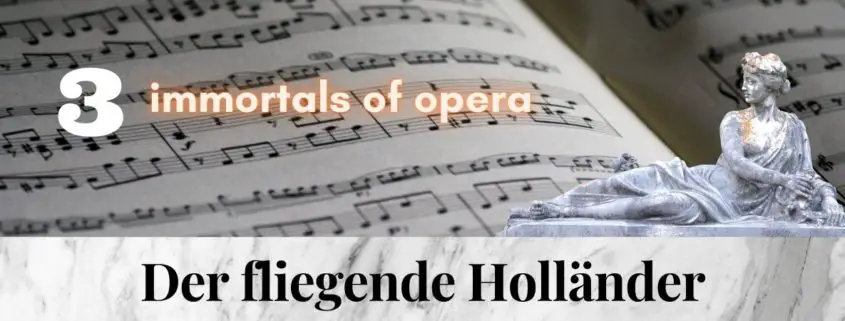3 immortal pieces from the opera DER FLIEGENDE HOLLÄNDER (THE FLYING DUTCHMAN) by Verdi – with the best interpretations from YouTube (Hits, Best of)
With the “Flying Dutchman” Wagner succeeded in creating his first masterpiece. The perfect orchestral language, the grandiose leitmotifs and the magnificent choral scenes make this work one of the German composer’s top works.
The leitmotifs of the overture
Synopsis: Daland is caught in a storm with his merchant ship and has to seek refuge in a protective bay called Sandwike.
The opera begins with one of Wagner’s incomparable overtures. The stormy sea is painted as in a symphonic poem. Rossini’s and Meyerbeer’s storms are only a gentle breeze compared to Wagner’s hurricane. We hear three important leitmotifs in this opening piece. Right at the beginning we hear the Dutchman motif:
Shortly thereafter the concise ghost motif:
After this section we hear a lyrical theme, the so-called redemption motif
And shortly afterwards the love motif:
The storm sets in again and the sailor song “Steuermann, lass die Wacht”, which we will hear in Act 3, is heard. At the end the mood calms down again and with the theme of the redemption motif the overture ends solemnly.
Overture – Klemperer / Philharmonia
Senta’s Ballad
Daland’s daughter Senta is immersed in the painting of the Flying Dutchman, whose story Mary had told her. Senta tells the spinners about her role as savior.
According to Wagner, he first wrote this ballad and it became the pivotal point of the music and the drama of the composition. Senta tells the story of the Dutchman in the ballad and the most important leitmotifs appear. In the first two verses we hear the story of the Dutchman. This part begins with the motive of the Dutchman of the orchestra followed by Senta’s sung ghost motive and it ends with the redemption motive. Afterwards the girls join in with the redemption motif in a moved manner and Senta ends the ballad ecstatically with the wish to redeem the Dutchman.
A delicacy is Kirsten Flagstad’s ballad from the 30s. Flagstadt was one of the most important Wagner singers, her voice hatd a large volume and richness of sound even in dramatic passages.
Johohohe (1) – Flagstadt
Choir of the sailors
The villagers celebrate the arrival of the sailors with a festival on Daland’s ship. They call out to the sailors of the Dutchman, but it remains ghostly dark and quiet there.
With a transition music and without a break, the third act begins with the sailors’ choir. The choral parts of the “flying Dutchman” are overwhelming in their musical effect.
Steuermann lass die Wacht – Solti











Leave a Reply
Want to join the discussion?Feel free to contribute!